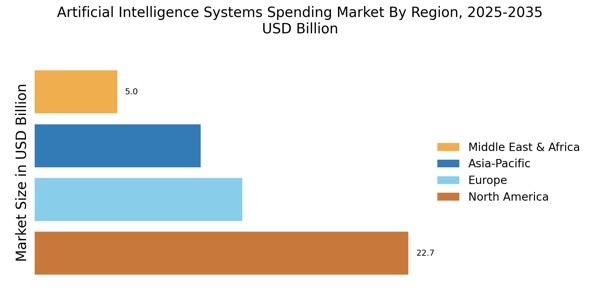The Artificial Intelligence Systems Spending Market is currently characterized by intense competition and rapid innovation, driven by the increasing demand for AI solutions across various sectors. Major players such as Microsoft (US), Google (US), and NVIDIA (US) are at the forefront, each adopting distinct strategies to enhance their market positioning. Microsoft (US) focuses on integrating AI capabilities into its cloud services, thereby facilitating digital transformation for enterprises. Google (US), on the other hand, emphasizes advancements in machine learning and natural language processing, aiming to enhance user experience and operational efficiency. NVIDIA (US) is strategically positioned as a leader in AI hardware, particularly in graphics processing units (GPUs), which are essential for AI computations. Collectively, these strategies not only bolster their competitive edge but also shape the overall dynamics of the market, fostering an environment ripe for innovation and collaboration.
In terms of business tactics, companies are increasingly localizing their operations and optimizing supply chains to enhance responsiveness to market demands. The competitive structure of the Artificial Intelligence Systems Spending Market appears moderately fragmented, with a mix of established giants and emerging players. This fragmentation allows for diverse offerings and innovation, as key players leverage their strengths to capture market share. The collective influence of these companies is significant, as they drive technological advancements and set industry standards.
In September 2025, Microsoft (US) announced a strategic partnership with a leading healthcare provider to develop AI-driven solutions aimed at improving patient outcomes. This collaboration underscores Microsoft's commitment to leveraging AI in critical sectors, potentially transforming healthcare delivery and enhancing operational efficiencies. Such partnerships not only expand Microsoft's market reach but also reinforce its position as a key player in the AI landscape.
In August 2025, Google (US) unveiled a new suite of AI tools designed for small and medium-sized enterprises (SMEs), aimed at democratizing access to advanced technologies. This initiative reflects Google's strategy to broaden its customer base and empower businesses with AI capabilities, thereby fostering innovation at all levels of the economy. By targeting SMEs, Google positions itself as a facilitator of digital transformation, which could lead to increased market penetration and customer loyalty.
In July 2025, NVIDIA (US) launched a new AI platform that integrates advanced machine learning capabilities with its existing GPU technology. This move is pivotal as it not only enhances NVIDIA's product offerings but also solidifies its leadership in the AI hardware market. The integration of AI with GPU technology is likely to drive further advancements in various applications, from autonomous vehicles to smart cities, thereby expanding NVIDIA's influence across multiple sectors.
As of October 2025, the competitive landscape is increasingly defined by trends such as digitalization, sustainability, and the integration of AI into everyday business processes. Strategic alliances are becoming more prevalent, as companies recognize the value of collaboration in driving innovation and addressing complex challenges. Looking ahead, competitive differentiation is expected to evolve, with a pronounced shift from price-based competition to a focus on innovation, technological advancement, and supply chain reliability. This transition may redefine how companies position themselves in the market, emphasizing the importance of agility and responsiveness to emerging trends.


















Leave a Comment